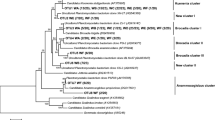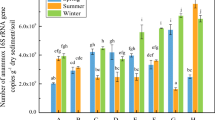Abstract
Anaerobic ammonium oxidation (anammox) was suggested to be involved in the nitrogen (N) removal process in constructed wetlands (CWs). Nevertheless, its occurrence and role in CWs treating swine wastewater have not been well evaluated yet. In this study, we investigated the diversity, activity, and role of anammox bacteria in sediments of mesoscale surface flow CWs (SFCWs) subjected to different N loads of swine wastewater. We found that anammox bacteria were abundant in SFCW sediments, as indicated by 7.5 × 105 to 3.5 × 106 copies of the marker hzsB gene per gram of dry soil. Based on stable isotope tracing, potential anammox rates ranged from 1.03 to 12.5 nmol N g−1 dry soil h−1, accounting for 8.63–57.1% of total N2 production. We estimated that a total N removal rate of 0.83–2.68 kg N year−1 was linked to the anammox process, representing ca. 10% of the N load. Phylogenetic analyses of 16S ribosomal RNA (rRNA) revealed the presence of multiple co-occurring anammox genera, including “Candidatus Brocadia” as the most common one, “Ca. Kuenenia,” “Ca. Scalindua,” and four novel unidentified clusters. Correlation analyses suggested that the activity and abundance of anammox bacteria were strongly related to sediments pH, NH4 +-N, and NO2 −-N. In conclusion, our results confirmed the presence of diverse anammox bacteria and indicated that the anammox process could serve as a promising N removal pathway in the treatment of swine wastewater by SFCWs.




Similar content being viewed by others
References
Bai R, Chen X, He JZ, Shen JP, Zhang LM (2015) Candidatus Brocadia and Candidatus Kuenenia predominated in anammox bacterial community in selected Chinese paddy soils. J Soils Sediment 15:1977–1986
Bao SD (2000) Chemical analysis for agricultural soil. China Agriculture Press, Beijing
Chen Y, Wen Y, Tang ZR, Huang JG, Zhou Q, Vymazal J (2015) Effects of plant biomass on bacterial community structure in constructed wetlands used for tertiary wastewater treatment. Ecol Eng 84:38–45
Coban O, Kuschk P, Kappelmeyer U, Spott O, Martienssen M, Jetten MSM, Knoeller K (2015) Nitrogen transforming community in a horizontal subsurface-flow constructed wetland. Water Res 74:203–212
Cronk JK (1996) Constructed wetlands to treat wastewater from dairy and swine operations: a review. Agric Ecosyst Environ 58:97–114
Dale OR, Tobias CR, Song B (2009) Biogeographical distribution of diverse anaerobic ammonium oxidizing (anammox) bacterial in Cape Fear River Estuary. Environ Microbiol 11:1194–1207
Dalsgaard T, Canfield DE, Petersen J, Thamdrup B, Acuňa-González J (2003) N2 production by the anammox reaction in the anoxic water column of Golfo Dulce, Costa Rica. Nature 422:606–608
Dalsgaard T, Thamdrup B, Canfield DE (2005) Anaerobic ammonium oxidation (anammox) in the marine environment. Res Microbiol 156:457–464
Deng L, Zheng P, Chen Z, Mahmood Q (2008) Improvement in post-treatment of digested swine wastewater. Bioresour Technol 99:3136–3145
Dong Z, Sun TH (2007) A potential new process for improving nitrogen removal in constructed wetlands—promoting coexistence of partial-nitrification and anammox. Ecol Eng 31:69–78
Erler DV, Eyre BD, Davison L (2008) The contribution of anammox and dentrification to sediment N2 production in a surface flow constructed wetland. Environ Sci Technol 42:9144–9150
Harrington C, Scholz M (2010) Assessment of pre-digested piggery wastewater treatment operations with surface flow integrated constructed wetland systems. Bioresour Technol 101:7713–7723
He Y, Tao W, Wang Z, Shayya W (2012) Effects of pH and seasonal temperature variation on simultaneous partial nitrification and anammox in free-water surface wetlands. J Environ Manag 110:103–109
Hu BL, Sheng LD, Zheng P, Hu AH, Chen TT, Cai C, Liu S, Lou LP (2012) Distribution and diversity of anaerobic ammonium-oxidizing bacteria in the sediments of the Qiantang River. Environ Microbiol Rep 4:540–547
Humbert S, Tarnawski S, Fromin N, Mallet MP, Aragno M, Zopfi J (2010) Molecular detection of anammox bacteria in terrestrial ecosystems: distribution and diversity. ISME J 4:450–454
Jetten MSM, Niftrik L, Strous M, Kartal B, Keltjens JT, Op den Camp HJM (2009) Biochemistry and molecular biology of anammox bacteria. Crit Rev Biochem Mol 44:65–84
Jetten MSM, Op den Camp HJM, Kuenen JG, Strous M (2010) Description of the order Brocadiales. In: Krieg NR, Staley JT, Hedlund BP, Paster BJ, Ward N, Ludwig W, Whitman WB (eds) Bergey’s manual of systematic bacteriology. Springer, Heidelberg, pp. 506–603
Jin RC, Yang GF, Yu JJ, Zheng P (2012) The inhibition of the anammox process: a review. Chem Eng J 197:67–79
Kadlec RH, Wallace SD (2009) Treatment wetlands, 2nd edn. Boca Raton, Florida
Kartal B, Keltjens JT, Jetten MSM (2008) Metabolism of anammox. In: Encyclopedia of life sciences (ELS). Wiley, Ltd: Chichester
Kartal B, Maalcke WJ, de Almeida NM, Cirpus I, Gloerich J, Geerts W, Op den Camp HJM, Harhangi HR, Janssen-Megens EM, Francoijs KJ, Stunnenberg HG, Keltjens JT, Jetten MSM, Strous M (2011) Molecular mechanism of anaerobic ammonium oxidation. Nature 479:127–130
Kumar S, Nei M, Dudley J, Tamura K (2008) MEGA: a biologist-centric software for evolutionary analysis of DNA and protein sequences. Brief Bioinform 9:299–306
Kuypers MMM, Sliekers AO, Lavik G, Schmid M, Jorgensen BB, Kuenen JG, Damste JSS, Strous M, Jetten MSM (2003) Anaerobic ammonium oxidation by anammox bacteria in Black Sea. Nature 422:608–611
Lam P, Jensen MM, Lavik G, McGinnis DF, Muller B, Schubert CJ, Amann R, Thamdrup B, Kuypers MMM (2007) Linking crenarchaeal and bacterial nitrification to anammox in the Black Sea. Proc Natl Acad Sci U S A 102:7104–7109
Ligi T, Truu M, Oopkaup K, Nõlvak H, Mander Ü, Mitsch WJ, Truu J (2015) The genetic potential of N2 emission via denitrification and ANAMMOX from the soils and sediments of a created riverine treatment wetland complex. Ecol Eng 80:181–190
Liu F, Zhang SN, Wang Y, Li Y, Xiao RL, Li HF, He Y, Zhang MM, Wang D, Li X, Wu JS (2016) Nitrogen removal and mass balance in newly-formed Myriophyllum aquaticum mesocosm during a single 28-day incubation with swine wastewater treatment. J Environ Manag 166:596–604
Long A, Heitman J, Tobias C, Philips R, Song B (2013) Co-occurring anammox, denitrification, and codenitrification in agricultural soils. Appl Environ Microb 79:168–176
Mulder A, Graaf AA, Robertson LA, Kuenen JG (1995) Anaerobic ammonium oxidation discovered in a denitrifying fluidized bed reactor. FEMS Microbiol Ecol 16:177–184
Neef A, Amann R, Schlesner H, Schleifer KH (1998) Monitoring a widespread bacterial group: in situ detection of Planctomycetes with 16S rRNA-targeted probes. Microbiol 144:3257–3266
Nie SA, Li H, Yang XR, Zhang ZJ, Weng BS, Huang FY, Zhu GB, Zhu YG (2015) Nitrogen loss by anaerobic oxidation of ammonium in rice rhizosphere. ISME J 9:2059–2067
Oshiki M, Shimokawa M, Fujii N, Satoh H, Okabe S (2011) Physiological characteristics of the anaerobic ammonium-oxidizing bacterium ‘Candidatus Brocadia sinica’. Microbiol 157:1706–1713
Paredes D, Kuschk P, Mbwette TSA, Stange F, Muller RA, Koser H (2007) New aspects of microbial nitrogen transformations in the context of wastewater treatment—a review. Eng life Sci 7:13–25
Peng JF, Song YH, Liu ZH, Gao HJ, Yu HB (2012) Performance of a novel circular-flow corridor wetland toward the treatment of simulated high-strength swine wastewater. Ecol Eng 49:1–9
Poach ME, Hunt PG, Reddy GB, Stone KC, Johnson MH, Grubbs A (2007) Effect of intermittent drainage on swine wastewater treatment by marsh-pond-marsh constructed wetlands. Ecol Eng 30:43–50
Schloss P, Westcott SL, Ryabin T, Hall JR, Hartmann M, Hollister EB, Lesniewski RA, Oakley BB, Parks DH, Robinson CJ, Sahl JW, Stres B, Thallinger GG, Van Horn DJ, Weber CF (2009) Introducing mothur: open-source, platfore-independent, community-supported software for describing and comparing microbial communities. Appl Environ Microbiol 75:7537–7541
Schmid MC, Maas B, Dapena A, van de Pas-Schoonen K, van de Vossenberg J, Kartal B, van Niftrik L, Schmidt I, Cirpus I, Kuenen JC, Wagner M, Sinninghe Damste JS, Kuypers M, Revsbech NP, Mendez R, Jetten MS, Strous M (2005) Biomarkers for in situ detection of anaerobic ammonium-oxidizing (anammox) bacteria. Appl Environ Microb 71:1677–1684
Schmid MC, Twachtmann U, Klein M, Strous M, Juretschko S, Jetten MSM, Metzger JW, Schleifer KH, Wagner M (2000) Molecular evidence for genus level diversity of bacteria capable of catalyzing anaerobic ammonium oxidation. Syst Appl Microbiol 23:93–106
Shen LD, Liu S, Lou LP, Liu WP, Xu XY, Zheng P, Hu BL (2013) Broad distribution of diverse anaerobic ammonium-oxidizing bacteria in Chinese agricultural soils. Appl Environ Microb 79:6167–6172
Shen LD, Wu HS, Gao ZQ, Xu XH, Chen TX, Liu S, Cheng HX (2015) Occurrence and importance of anaerobic ammonium-oxidising bacteria in vegetable soils. Appl Microbiol Biotechnol 99:5709–5718
Sonthiphand P, Hall MW, Neufeld JD (2014) Biogeography of anaerobic ammonia-oxidizing (anammox) bacteria. Front Microbiol 5:399
Strous M, Kuenen JG, Jetten MS (1999) Key physiology of anaerobic ammonium oxidation. Appl Environ Microb 65:3248–3250
Thamdrup B, Dalsgaard T (2002) Production of N2 through anaerobic ammonium oxidation coupled to nitrate reduction in marine sediments. Appl Environ Microb 68:1312–1318
Truu M, Juhanson J, Truu J (2009) Microbial biomass, activity and community composition in constructed wetlands. Sci Total Environ 407:3958–3971
van der Star WR, Miclea AI, van Dongen UG, Muyzer G, Picioreanu C, van Loosdrecht MC (2008) The membrane bioreactor: a novel tool to grow anammox bacteria as free cells. Biotechnol Bioeng 101:286–294
Vymazal J (2007) Removal of nutrients in various types of constructed wetlands. Sci Total Environ 380:48–65
Wang SY, Zhu GB, Peng YZ, Jetten MS, Yin CQ (2012) Anammox bacterial abundance, activity, and contribution in riparian sediments of the Pearl River estuary. Environ Sci Technol 46:8834–8842
Wang J, Gu JD (2013) Dominance of Candidatus Scalindua species in anammox community revealed in soils with different duration of rice paddy cultivation in Northeast China. Appl Microbiol Biotechnol 97:1785–1798
Weber K, Legge RL (2011) Dynamics in the bacterial community-level physiological profiles and hydrological characteristics of constructed wetland mesocosms during start-up. Ecol Eng 37:666–677
Woebken D, Fuchs BM, Kuypers MMM, Amamm R (2007) Potential interactions of particle-associated anammox bacteria with bacterial and archaeal partners in the Namibian upwelling system. Appl Environ Microb 73:4648–4657
Yang RX, Li H, Nie SN, Su JQ, Weng BS, Zhu GB, Yao HY, Gilbert JA, Zhu YG (2015) Potential contribution of anammox to nitrogen loss from paddy soils in southern China. Appl Environ Microb 81:938–947
Zhang Y, Ruan XH, Op den Camp HJM, Smits TJM, Schmid MC (2007) Diversity and abundance of aerobic and anaerobic ammonium-oxidizing bacteria in freshwater sediments of the Xinyi River (China). Environ Microbiol 9:2375–2382
Zhu GB, Wang SY, Wang WD, Wang Y, Zhou LL, Jiang B, Op den Camp HJM, Risgaard-Petersen N, Schwark L, Peng YZ, Hefting MM, Jetten MSM, Yin CQ (2013) Hotspots of anaerobic ammonium oxidation at land-freshwater interfaces. Nat Geosci 6:103–107
Zhu GB, Wang SY, Wang Y, Wang CX (2011a) Anaerobic ammonia oxidation in a fertilized paddy soil. ISME J 5:1905–1912
Zhu GB, Wang SY, Feng XJ, Fan GN, Jetten MSM, Yin CQ (2011b) Anammox bacterial abundance, biodiversity and activity in constructed wetland. Environ Sci Technol 45:9951–9958
Acknowledgements
We sincerely thank Hu Li and San’an Nie (Key Laboratory of Urban Environment and Health, Institute of Urban Environment, Chinese Academy of Science, Xiamen, China) for their skillful assistance of the 15N isotope-pairing experiments. Special thanks to Public Service Technology Center, Institute of Subtropical Agriculture, Chinese Academy of Sciences, for instrument support. This study was funded by the China Postdoctoral Science Foundation Funded Project (2014M560648, 2015T80878), the National Natural Science Foundation of China (41601272), the National Science and Technology Supporting Project (2014BAD14B05), and the key CAS Programs (KZZD-EW-11).
Author information
Authors and Affiliations
Corresponding author
Ethics declarations
This article does not contain any studies with human participants or animals performed by any of the authors.
Conflict of interest
The authors declare that they have no conflict of interest.
Electronic supplementary material
ESM 1
(PDF 154 kb)
Rights and permissions
About this article
Cite this article
Chen, L., Liu, F., Jia, F. et al. Anaerobic ammonium oxidation in sediments of surface flow constructed wetlands treating swine wastewater. Appl Microbiol Biotechnol 101, 1301–1311 (2017). https://doi.org/10.1007/s00253-016-7957-y
Received:
Revised:
Accepted:
Published:
Issue Date:
DOI: https://doi.org/10.1007/s00253-016-7957-y




